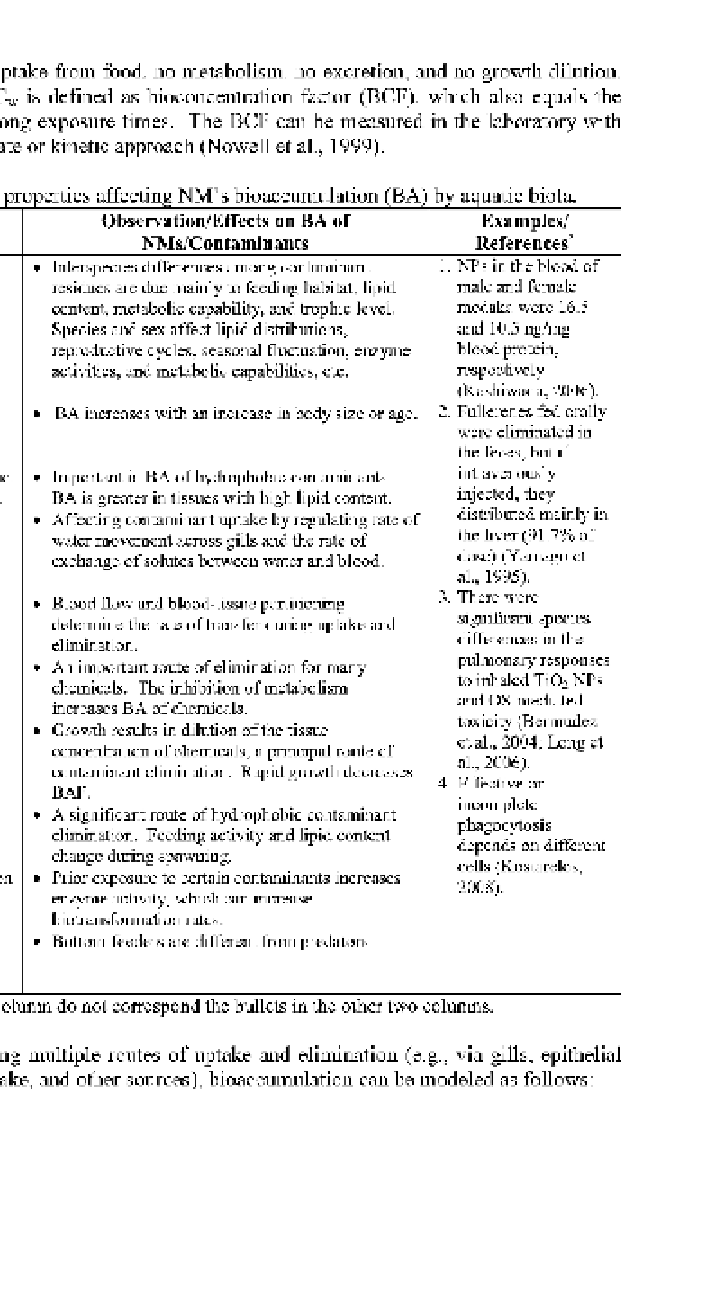Environmental Engineering Reference
In-Depth Information
there is no NM uptake from food, no metabolism, no excretion, and no growth dilution.
The ratio of CVC
W
is defined as bioconcentration factor (BCF), which also equals the
ratio of ki/k2 at long exposure times. The BCF can be measured in the laboratory with
either a steady-state or kinetic approach (Nowell et al., 1999).
Table 15.8
Biota properties affecting NM's bioaccumulation (BA) by aquatic biota.
Observation/Effects on BA of
NMs/Contaminants
• Interspecies differences among contaminant
residues are due mainly to feeding habitat, lipid
content, metabolic capability, and trophic level.
Species and sex affect lipid distributions,
reproductive cycles, seasonal fluctuation, enzyme
activities, and metabolic capabilities, etc.
Examples/
References*
1. NPs in the blood of
male and female
medaka were 16.5
and 10.5 ng/mg
blood protein,
respectively
(Kashiwada, 2006).
2. Fullerenes fed orally
were eliminated in
the feces, but if
intravenously
injected, they
distributed mainly in
the liver (9 1.7% of
dose) (Yamago et
al., 1995).
3 . There were
significant species
differences in the
pulmonary responses
to inhaled TiO
2
NPs
and OS-mediated
toxicity (Bermudez
et al 2004' Long et
al., 2006).
4. Effective or
incomplete
phagocytosis
depends on different
cells (Kostarelos,
2008).
• BA increases with an increase in body size or age.
• Lipid Content and
Tissue Analyzed
• Important in BA of hydrophobic contaminants.
BA is greater in tissues with high lipid content.
• Affecting contaminant uptake by regulating rate of
water movement across gills and the rate of
exchange of solutes between water and blood.
• Blood flow and blood-tissue partitioning
determine the rate of transfer during uptake and
elimination.
• An important route of elimination for many
chemicals. The inhibition of metabolism
increases BA of chemicals.
• Growth results in dilution of the tissue
concentration of chemicals, a principal route of
contaminant elimination. Rapid growth decreases
BAF.
• A significant route of hydrophobic contaminant
elimination. Feeding activity and lipid content
change during spawning.
• Prior exposure to certain contaminants increases
enzyme activity, which can increase
biotransformation rates.
• Bottom- feeders are different from predators.
• Enzyme Induction
1
Numbers in this column do not correspond the bullets in the other two columns.
Considering multiple routes of uptake and elimination (e.g., via gills, epithelial
tissue, dietary intake, and other sources), bioaccumulation can be modeled as follows:

Search WWH ::

Custom Search